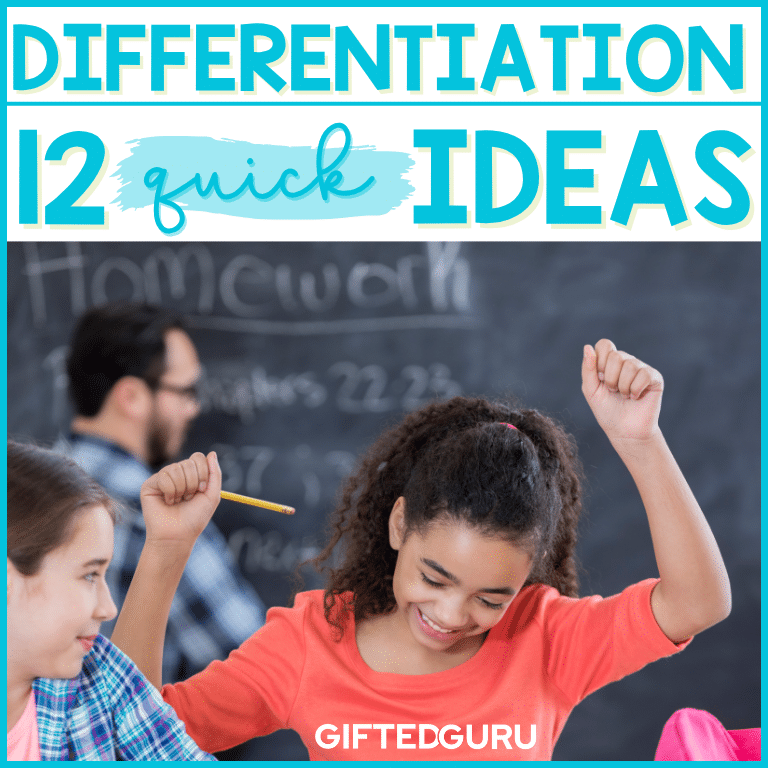
After decades in gifted education, I’ve learned one thing: teachers don’t need more theory. You need practical strategies that work on Tuesday morning when you have 28 kids, three different readiness levels, and approximately 47 seconds to implement differentiation before someone needs a bandaid or the bathroom.
This isn’t an article about why differentiation matters. You already know it does. This is about what you can actually do about it.
Here are twelve strategies that require minimal prep, work across content areas, and genuinely challenge gifted learners without creating extra grading for you. Some are quick tweaks. Others are structured approaches. All of them work.
1. Choice Menus: Let Students Pick Their Format
This one’s obvious, but it’s obvious because it works.
Instead of assigning everyone the same essay or worksheet, give students a menu of ways to demonstrate mastery OR ways to learn the material (an often-overlooked menu option).
✅To differentiate for ability, make sure the thinking levels of the choices are varied.
✅To differentiate for interest, you simply need choices.
If you want to make sure your choice menus are strong, I’ve got a great article on making choice menus better.
2. The “So What?” Question Stack
This is my go-to for pushing deeper thinking in the moment, with zero prep.
When a gifted student answers a question (even correctly) don’t stop there.
Ask: “So what?” or “Why does that matter?” or “What does that mean for…?”
What it looks like:
- Student: “The protagonist changes by the end.”
- You: “So what? Why does that matter to the reader?”
- Student: “It shows that people can grow.”
- You: “And why is that significant in the context of the time period this was written?”
You’re essentially building a ladder of questions that forces students to climb from knowledge to analysis to evaluation. Each “so what” pushes them one rung higher.
It takes practice to get comfortable with this, but once you do, it becomes second nature.
3. Exit Ticket Leveling
Not all students need the same exit question, and that’s okay.
While your whole class might be working on the same concept, your exit tickets can—and should—vary based on readiness.
What it looks like:
- Standard exit ticket: “What are three causes of the Civil War?”
- Advanced exit ticket: “Which cause of the Civil War was most difficult to prevent, and how might history have changed if that factor hadn’t existed?”
The advanced version requires synthesis and evaluation, not just recall. You’re assessing the same content, but you’re asking different questions about it.
This also means you’re not drowning in identical responses. The variety makes grading more interesting, which is a gift to yourself. You’re welcome.
4. Create a “Misconceptions” Mini-Unit
Here’s something I’ve seen work beautifully: have advanced students identify and debunk common misunderstandings about the topic you’re studying.
This builds critical thinking because they have to understand the content deeply enough to recognize where people typically go wrong, and then explain why those misconceptions exist and how to correct them.
What it looks like:
- “Many people think all triangles have a right angle. Why do you think people believe this? What examples prove this wrong? Create a lesson to teach someone the truth.”
- “Some people think the Civil War was only about slavery, while others think it had nothing to do with slavery. Why do both misconceptions exist? What’s the accurate, nuanced truth?”
This works across all content areas. Students become error detectives and truth-tellers.
Since gifted kids love feeling like they know something no one else knows, this is perfection for them!
5. Open-Ended Problem Solving
Instead of multiple choice or single-solution problems, give prompts that have multiple valid approaches.
“Show me three different ways to solve this” is magic. It immediately shifts the task from “get the right answer” to “demonstrate flexible thinking.”
What it looks like:
- Math: “Solve this problem using at least two different methods. Which is most efficient? Why?”
- Science: “Design three different experiments that could test this hypothesis. What are the pros and cons of each?”
- ELA: “Identify three different themes in this text. Which is most central? Defend your choice.”
No prescribed format. No single correct answer. Just rigorous thinking.
6. Anchor Activities
If you don’t have a standing list of challenging tasks that gifted students can jump into when they finish early, you’re setting yourself up for the dreaded “I’m done, now what?” followed by the student becoming a tutor for their peers. (I’ve written an entire article about why that’s problematic.)
Anchor activities are always-available, high-interest challenges that students can work on independently.
What it looks like:
- Logic puzzles and riddles
- Independent research projects on student-selected topics
- Venn diagrams comparing complex concepts
- “Expert of the week” mini-investigations
- Create-your-own-problem challenges
The key is that these are genuinely challenging and interesting, not busywork. Students should want to work on them.
For more on this, check out my articles on fast finishers for students and fast finishers for teachers.
7. Shark Tank for Ideas
This is a quick, energizing strategy that gets students talking about their thinking.
Pair students for two-minute exchanges where they explain their thinking to each other, then switch partners and do it again.
What it looks like:
- Students work on a problem or analyze a text
- Set a timer for 2 minutes
- Partner A explains their thinking to Partner B
- Switch: Partner B explains to Partner A
- Find new partners and repeat
By the third or fourth round, students have refined their explanations significantly. They’ve heard other perspectives. They’ve adjusted their thinking.
It’s like think-pair-share on espresso, and it works because the time limit creates urgency and focus.
8. The “Constraints” Twist
Want to make something instantly more challenging? Add constraints.
Gifted students often find tasks too easy, but adding limitations forces them to think more carefully and creatively.
What it looks like:
- “Explain this concept like you’re talking to a 5-year-old”
- “Write your argument in exactly 50 words, no more, no fewer”
- “Solve this problem without using a calculator”
- “Describe this historical event using only single-syllable words”
Constraints force precision. They eliminate the ability to rely on complexity or jargon. Students have to truly understand the content to work within the limitations.
I’m not sure why I put this at number 8. It’s probably my number one go-to strategy.
9. “Prove the Opposite” Task
This is one of my favorites because it teaches nuance and prevents black-and-white thinking.
Have students build the strongest possible argument for the opposite viewpoint, even if they don’t agree with it (maybe *especially* if they don’t agree with it!).
What it looks like:
- “You believe X. Now argue for Y as convincingly as possible.”
- “The protagonist made this choice. Defend the opposite choice.”
- “This was the author’s message. What’s the strongest counterargument to that message?”
This develops intellectual empathy. Students learn that smart people can disagree, and that understanding opposing viewpoints makes their own arguments stronger.
It’s also a stealth way to teach civil discourse, which we desperately need.
10. Think-Pair-Share with a Twist
This is a quick, energizing strategy that gets students talking (and truly listening) to each other’s thinking.
Pair students for brief exchanges where they explain their ideas to each other. Then comes the twist: when you call on students or they pair up again, they share their partner’s idea, not their own.
What it looks like:
- Students work on a problem or analyze a text
- Set a timer for 2 minutes
- Partner A explains their thinking to Partner B
- Partner B explains their thinking to Partner A
- When called on (or when sharing with another partnership), students explain what their partner said
This forces actual listening. Students can’t just wait for their turn to talk. They have to understand their partner’s thinking well enough to represent it accurately to someone else.
It’s also faster and more focused than traditional share-outs because students are accountable for listening, not just speaking.
11. Curated Resource Lists
Keep a ready-to-go list of articles, videos, documentaries, and websites on topics of common interest so gifted kids can self-direct their learning. Find out what your kids are fascinated with (axolotls, space, bones, and dinosaurs are often crowd favorites) and gather information about them, the more bizarre, the better.
This is prep work that pays dividends. Once you’ve built these lists, you can use them year after year.
What it looks like:
- Organize by topic or theme
- Include a range of difficulty levels
- Mix media types (articles, videos, podcasts, interactive sites)
- Update annually to keep content fresh
When students finish early or want to go deeper, they have immediate access to high-quality resources. You’re not scrambling to find something for them to do, and they’re not stuck waiting.
I recommend keeping these in a digital format (Google Doc, shared drive, learning management system) so students can access them independently.
12. “Create the Problem” Challenge
This one flips the script entirely: give students the answer or endpoint, and have them create the problem, question, or scenario that leads to it.
What it looks like:
- Math: “The answer is 42. Write five different problems that would result in this answer.”
- Science: “This is the data from an experiment. What was the research question? What was the hypothesis?”
- History: “This was the outcome. What events led to it? Create a timeline backward.”
- ELA: “This is the final line of a story. Write the story that leads to this ending.”
This requires deep understanding. Students can’t just memorize or recall—they have to understand the underlying structure and relationships well enough to reverse-engineer them.
It’s challenging, creative, and genuinely engaging for strong thinkers.
The Real Issue: Making It Sustainable
Here’s what I know after all these years: you won’t use strategies that are complicated or time-consuming, no matter how effective they might be.
That’s not a character flaw. That’s reality.
These twelve strategies work because they’re practical. Most require no additional materials. Many take seconds to implement. All of them can be adjusted to fit your content, your grade level, and your teaching style.
The goal isn’t to use all twelve every week. The goal is to have a toolbox of options so that when you need to differentiate (and you will need to differentiate) you have something you can actually use.
Start with one. Try it for a week. See what happens. Then add another.
Differentiation doesn’t have to be overwhelming. It just has to happen.
Want to Go Deeper?
If you’re ready to build a systematic approach to differentiation that works for your classroom, your content, and your students, I’d love to have you join my Differentiation Professional Development Course.
It’s designed for real teachers in real classrooms who need practical strategies that actually work—not theoretical frameworks that look good on paper but fall apart by third period.
You’ll learn how to:
- Plan differentiated lessons from the start (instead of scrambling to add them later)
- Assess readiness, interest, and learning profile efficiently
- Create tiered assignments that genuinely challenge all learners
- Manage a differentiated classroom without losing your mind
Because at the end of the day, gifted kids deserve to learn something new. And you deserve strategies that make that possible without adding three hours to your evening.
Let’s make it happen.
Can we be inbox friends?
You’ll get tips for teachers & parents of gifted kids, ideas, freebies, and the inside scoop on new resources (with super great sales of course).
You can unsubscribe anytime (but I hope you won’t because I love sharing great stuff!)
~ Lisa
Thank you!
You’re in the incrowd now!
Here are links to the files:
* 15 Ways to Help Gifted Kids Thrive in School
If you’re on Instagram, let’s connect!
See you soon,
~Lisa



